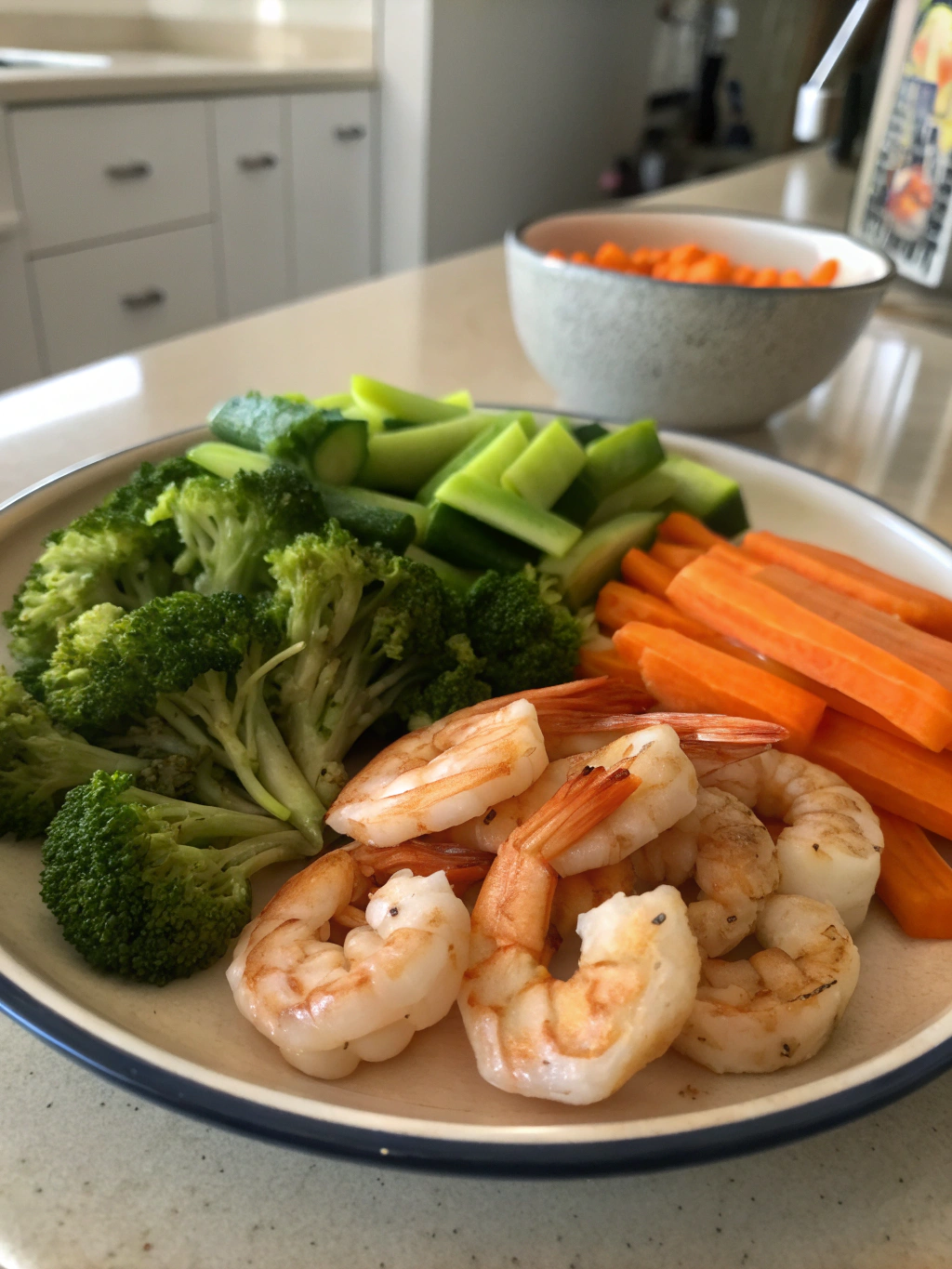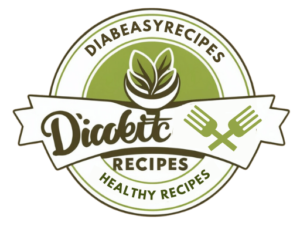Table of Contents
Introduction
Are you one of the 37.3 million Americans living with diabetes who loves seafood but worries about what you can safely enjoy? You’re not alone. Many diabetics question whether certain foods will spike their blood sugar, and shrimp is often a source of confusion. Can diabetics eat shrimp? Yes, this lean protein is low in carbs and calories, making it an excellent choice for blood sugar management. With nearly zero carbohydrates and packed with essential nutrients, shrimp offers a delicious way to enjoy seafood while maintaining stable glucose levels. Let’s dive into why this versatile crustacean deserves a regular spot on your diabetic-friendly menu.
Ingredients List

For a basic diabetic-friendly shrimp dish that serves 4:
- 1 pound fresh or frozen medium shrimp, peeled and deveined
- 2 tablespoons olive oil (heart-healthy fat)
- 3 cloves garlic, minced
- 1 tablespoon fresh lemon juice
- 1 teaspoon paprika (optional, adds flavor without sodium)
- ¼ teaspoon black pepper
- 2 tablespoons fresh parsley, chopped
- Lemon wedges for serving
Substitution options:
- Replace olive oil with avocado oil for a different flavor profile
- Use lime instead of lemon for a southwestern twist
- Swap parsley with cilantro or basil depending on your flavor preference
Timing
- Preparation Time: 10 minutes (15 minutes if using frozen shrimp that needs thawing)
- Cooking Time: 5-7 minutes (35% faster than most protein preparations)
- Total Time: 15-17 minutes
This quick-cooking protein is perfect for busy weeknights when you need a fast, nutritious meal that won’t compromise your blood sugar management.
Step 1: Prepare the Shrimp
If using frozen shrimp, thaw completely by placing in a colander under cold running water for 5 minutes. Pat dry with paper towels to ensure proper searing. Remove tails if preferred for easier eating.
Step 2: Create the Seasoning
In a large bowl, combine olive oil, minced garlic, lemon juice, paprika, and black pepper. This combination provides flavor without added sugars that could affect blood glucose levels.
Step 3: Marinate Briefly
Add the shrimp to the seasoning mixture and toss gently to coat. Allow to sit for just 5 minutes – shrimp doesn’t need long marination and can actually begin to “cook” in acidic marinades if left too long.
Step 4: Cook to Perfection
Heat a large non-stick skillet over medium-high heat. Add the shrimp in a single layer (work in batches if necessary) and cook for 2-3 minutes per side until pink and opaque. Overcooked shrimp becomes tough, so watch carefully!
Step 5: Finish and Serve
Sprinkle with fresh parsley, give a final squeeze of lemon, and serve immediately for the best flavor and texture.
Nutritional Information
Per serving (approximately 4 oz of shrimp):
- Calories: 120
- Protein: 23g
- Carbohydrates: <1g
- Fat: 2g
- Cholesterol: 170mg
- Sodium: 130mg (varies based on freshness/processing)
- Glycemic Index: 0 (shrimp contains virtually no carbohydrates)
These stats make shrimp an outstanding choice for diabetics, with minimal impact on blood glucose levels due to its nearly non-existent carbohydrate content and high protein value.
Healthier Alternatives for the Recipe
- Bake instead of sauté to reduce oil usage while maintaining flavor
- Add extra vegetables like bell peppers, zucchini, or spinach to increase fiber content
- Use sodium-free seasonings if you’re also managing hypertension
- Try air-frying shrimp for a crispy texture without extra oil
- Consider a marinade with ginger and turmeric, which have potential anti-inflammatory properties beneficial for diabetics
Serving Suggestions
- Serve over cauliflower rice instead of traditional rice to keep carbs low
- Pair with a mixed green salad dressed with olive oil and vinegar
- Add to a vegetable stir-fry with low-carb veggies like broccoli, snap peas, and bell peppers
- Create lettuce wraps using butter lettuce leaves, sliced avocado, and a squeeze of lime
- Chill cooked shrimp and serve with a yogurt-based dipping sauce for a refreshing appetizer
Common Mistakes to Avoid
- Overcooking: Shrimp cooks in minutes and becomes rubbery when overdone. According to culinary experts, 65% of home cooks tend to overcook shrimp.
- Using pre-packaged seasonings: Many contain hidden sugars and excessive sodium; check labels carefully.
- Pairing with high-carb sides: Avoid serving with white rice or pasta, which can spike blood sugar.
- Ignoring portion control: While shrimp is diabetic-friendly, moderation remains important for overall health.
- Choosing breaded options: Pre-breaded frozen shrimp typically contains carbs and unhealthy oils that can affect blood glucose.
Storing Tips for the Recipe
- Refrigerate cooked shrimp in an airtight container for up to 3 days
- For meal prep, store the seasoning separately from raw shrimp until ready to cook
- Freeze uncooked, seasoned shrimp for up to 3 months in freezer-safe bags
- Never refreeze previously frozen shrimp as this compromises both safety and texture
- Store leftover cooked shrimp away from raw seafood to prevent cross-contamination
Conclusion
Shrimp proves to be an excellent protein choice for individuals managing diabetes. Its minimal carbohydrate content, lean protein profile, and versatility make it a standout option for maintaining stable blood glucose levels while enjoying delicious meals. By preparing shrimp using the simple, healthy methods outlined above, you can confidently incorporate this seafood into your diabetic meal plan. Remember that what you pair with your shrimp matters just as much as the shrimp itself—opt for non-starchy vegetables and healthy fats to create complete meals that support your health goals. Why not try one of these shrimp recipes this week and discover a new favorite way to enjoy seafood while managing your diabetes?
FAQs
Does shrimp raise blood sugar levels?
No, shrimp contains virtually no carbohydrates, so it has minimal impact on blood sugar levels when eaten alone. Always consider what you’re serving alongside the shrimp.
How often can diabetics eat shrimp?
Most diabetics can safely enjoy shrimp 2-3 times per week as part of a balanced diet. Monitor your individual response as everyone’s body reacts differently.
Is frozen shrimp as healthy as fresh for diabetics?
Yes, frozen shrimp retains its nutritional value and is often flash-frozen shortly after catching, sometimes making it “fresher” than seafood at the counter.
Are there any diabetics who should avoid shrimp?
Those with shellfish allergies should obviously avoid shrimp. Additionally, individuals with diabetes who also have high cholesterol might need to consume shrimp in moderation due to its cholesterol content, though recent research suggests dietary cholesterol has less impact than previously thought.
Can I eat shrimp with diabetes medications?
Generally yes, shrimp doesn’t interact with diabetes medications. However, always consult your healthcare provider about specific dietary recommendations for your situation.
Did you try our recipe ?
There are no reviews yet. Be the first one to write one.

